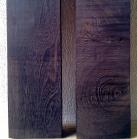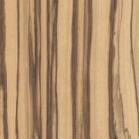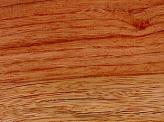AFRICAN BLACKWOOD
African blackwood (dalbergia melanoxylon) is the most expensive woods in the world because it comes from a slow-growing near-threatened tree. It grows in dry savanna regions in southern and central Africa. This multi-stemmed tree grows to about 25 feet tall on average.
MAHOGANY SAPELI
Mahogany is a commercially important lumber prized for its beauty, durability, and color, and used for paneling and to make furniture, boats, musical instruments and other items.
Among the many types of Mahogany, Mahogany Sapelli features the most saturated reddish-brown or purple-brown color and aroma of cedar.
Among the many types of Mahogany, Mahogany Sapelli features the most saturated reddish-brown or purple-brown color and aroma of cedar.
AFRICAN WALNUT
The wood has a golden, bronze to reddish brown color with irregular lines of dark gray, yellow, green and brown. So was named Tigerwood. It is extremely hard, heavy, close-grained, and resists water well, making it a valuable hardwood. Increasing that value is the fact that it can come in large sizes, has an attractive appearance and easy to shape with tools.
PADAUK
Padauk wood is obtained from several species of Pterocarpus. All padauks are of African or Asian origin. Padauks are valued for their toughness, stability in use, and decorativeness, most having a reddish wood.
African Padauk, when freshly cut, is a very bright red/orange but when exposed to sunlight fades over time to a warm brown. Its colour makes it a favourite among woodworkers.
Padauks can be confused with rosewoods to which they are somewhat related.
African Padauk, when freshly cut, is a very bright red/orange but when exposed to sunlight fades over time to a warm brown. Its colour makes it a favourite among woodworkers.
Padauks can be confused with rosewoods to which they are somewhat related.
AZOBE
Azobe is a rare tree species found in West and Central Africa, including the countries of Ivory Coast, Nigeria, Ghana, Cameroon, and the Congo states. The tree grows primarily in groups.
Azobe is a large tree reaching heights of 30-50 m (98-164 ft). The straight and cylindrical trunk is 60-160 cm (2-5 ft) in diameter, and is clear of branches for up to 30 m (98 ft). The scale-like bark is fibrous with strong red marks.
Azobe is a large tree reaching heights of 30-50 m (98-164 ft). The straight and cylindrical trunk is 60-160 cm (2-5 ft) in diameter, and is clear of branches for up to 30 m (98 ft). The scale-like bark is fibrous with strong red marks.
LOURO PRETO
Louro preto is a pretty wood with decent contrast. It resembles a brown and gold rosewood and can be dyed red or orange to look like a Brazilian rosewood. Can have pleasant characteristic scent.
Louro preto is often praised for its attractive grain
Louro preto is often praised for its attractive grain
TALI
Up to 100 to 140 ft in height; with a bole length of 30 to 50 ft, usually irregular often buttressed; trunk diameters 3 to 5 ft. Seed and bark are poisonous if ingested
BUBINGA
Bubinga is a beautiful wood species, but the charm of wood is always more than impressive color. Bubinga’s rich reddish tones are laced with darker annual ring lines that can produce striking flatsawn surfaces, such as for showy panels.
On the other hand, the lines are more subdued and uniform on rift and quartered faces. Riftsawn Bubinga thus makes an excellent choice for shaped table legs, for example, where, rather than competing with the designed curves, it gives them importance with its visual and physical weight.
Bubinga is an incredibly strong wood by any measure. It is denser than white oak, hard maple and almost all other common domestic species, on par with honey mesquite. Its surface hardness approaches double that of white oak, and even slightly exceeds persimmon, which is used for golf club heads!
The shear strength of bubinga is particularly exceptional, exceeding nearly every other commercial species, so it is extremely resistant to splitting. In summary, don’t worry too much about this stuff denting, splitting or breaking.
On the other hand, the lines are more subdued and uniform on rift and quartered faces. Riftsawn Bubinga thus makes an excellent choice for shaped table legs, for example, where, rather than competing with the designed curves, it gives them importance with its visual and physical weight.
Bubinga is an incredibly strong wood by any measure. It is denser than white oak, hard maple and almost all other common domestic species, on par with honey mesquite. Its surface hardness approaches double that of white oak, and even slightly exceeds persimmon, which is used for golf club heads!
The shear strength of bubinga is particularly exceptional, exceeding nearly every other commercial species, so it is extremely resistant to splitting. In summary, don’t worry too much about this stuff denting, splitting or breaking.
TCHITOLA
Tchitola is from Tropical West Africa.
Heartwood copper red brown with dark gum rings, suggesting Palisander.
Heartwood copper red brown with dark gum rings, suggesting Palisander.
RED ZEBRANO - EBIARA
Ebiara, Berlinia Bracteosa, (or Red Zebra Wood) grows in equatorial West Africa in Cameroon, Gabon, Sierra Leone, Ivory Coast, Congo and Zaire. The wood that is produced from this tree looks like a hybrid cross of Zebra wood and Bubinga. It has the beautiful reds of Bubinga with the striking stripes of Zebra in one species! Sapwood is whitish pink with heartwood ranging from red to brown with purple veins.
Wood works easier than Zebra or Bubinga as it is slightly less dense.
Uses include boxes, cabinets, picture frames, turned articles, and other high end uses.
We are sure that you will be as excited about this species as we are!
Wood works easier than Zebra or Bubinga as it is slightly less dense.
Uses include boxes, cabinets, picture frames, turned articles, and other high end uses.
We are sure that you will be as excited about this species as we are!
IROKO - African TEAK
Iroko is a large hardwood tree from the west coast of tropical Africa.
It is referred to as African Teak. Iroko does not require regular treatment with oil or varnish when used outdoors. It is a very durable wood. The wood is used for a variety of purposes including joinery, boatbuilding, piling and marine work, domestic flooring, furniture, veneer, railroad crossties, cabinetwork, shop fittings, etc..
Due to its characteristics and vast variety of uses Iroko is suggested as a Teak substitute.
It is referred to as African Teak. Iroko does not require regular treatment with oil or varnish when used outdoors. It is a very durable wood. The wood is used for a variety of purposes including joinery, boatbuilding, piling and marine work, domestic flooring, furniture, veneer, railroad crossties, cabinetwork, shop fittings, etc..
Due to its characteristics and vast variety of uses Iroko is suggested as a Teak substitute.
TEAK GUYANA
Well-formed tree to a height of 150 ft and diameters to 5 ft but more commonly to 3 ft Boles are clear for 60 to 80 ft over heavy buttresses.
MAHOGANY AFRICAN - Acajou
Reaches heights of 180 to 200 ft; boles are straight, cylindrical, and clear to 90 ft; trunk diameters are 3 to 6 ft, buttressed.
ETIMOE (African rosewood)
Etimoe is West African hardwood sometimes known as the African rosewood because of its similarity to the beautiful rosewoods. Of course this association is not botanically correct.
The true rosewoods include Honduran rosewood, Indian rosewood and Brazilian rosewood. All three are striking woods that vary from dark red to rose to dark purplish brown, with prominent dark striping.
Yet, etimoe does offer enough of a resemblance to be used as a rosewood substitute. The heartwood is reddish-brown to grey brown and features definite black to reddish veining or striping. Etimoe has a straight to interlocked grain with a fine, even texture.
The true rosewoods include Honduran rosewood, Indian rosewood and Brazilian rosewood. All three are striking woods that vary from dark red to rose to dark purplish brown, with prominent dark striping.
Yet, etimoe does offer enough of a resemblance to be used as a rosewood substitute. The heartwood is reddish-brown to grey brown and features definite black to reddish veining or striping. Etimoe has a straight to interlocked grain with a fine, even texture.
PURPLEHEART
Trees grow to heights of 170 ft with diameters to 4 ft, but usually 1.5 to 3 ft; boles are straight, cylindrical, and clear 60 to 90 ft above buttresses up to 12 ft. high.
TATAJUBA
Rather infrequent occurrence in the Guianas and the Brazilian Amazon.
A large, well-formed, unbuttressed canopy tree with a flat, umbrella-shaped crown. The trees are generally 20 to 24 in. in diameter, and 90 to 100 ft in height. The bole is cylindrical and 60 to 70 ft high. Bark, when cut, yields large quantities a sweet, sticky latex.
Unseasoned heartwood is yellow, often streaked with brown, becoming lustrous golden-brown to russet on exposure.
A large, well-formed, unbuttressed canopy tree with a flat, umbrella-shaped crown. The trees are generally 20 to 24 in. in diameter, and 90 to 100 ft in height. The bole is cylindrical and 60 to 70 ft high. Bark, when cut, yields large quantities a sweet, sticky latex.
Unseasoned heartwood is yellow, often streaked with brown, becoming lustrous golden-brown to russet on exposure.
JONGO KABBES
Sometimes to a height of 125 ft with trunk diameters to 6 ft, commonly to 3 ft, boles have narrow high buttresses and may be clear for 70 ft.
JABOTY
Trees to heights of 100 ft. sometimes attaining 200ft; with diameter to 100 cm. Clear stems extend to 60 or 70 ft. light to heavily buttressed.
Heartwood light brown, sometimes pink brown, more or less dark, sometimes with red or purplish shades.
Heartwood light brown, sometimes pink brown, more or less dark, sometimes with red or purplish shades.
BERG GRONFOLO
Trees to heights of 100 ft, sometimes attaining 200 ft; with diameters to 25 in., reaching 40 in. occasionally. Clear stems extend to 60 or 70 ft. Light to heavily buttressed.
DON CEDAR
A large tree 100 to 160 ft tall with a trunk diameter of 5 to 9 ft. Trees felled in Huanuco Province of Peru were up to 4 ft in diameter with merchantable heights of 4 ft and more.
PARTRIDGE WOOD
Evergreen, unbuttressed, moderate-sized trees; diameters of 20 to 28 in., heights of 90 to 120 ft, and clear boles 60 to 70 ft long are not uncommon.
GELE KABBES
Sometimes to a height of 125 ft with trunk diameters to 6 ft, commonly to 3 ft, boles have narrow high buttresses and may be clear for 70 ft.
KOPIE
A large buttressed, semi-deciduous, canopy tree; grows to a height of 130 ft and with diameters to 36 in., but usually 20 to 24 in.
MERIE
Heights 90 to 120 ft with long cylindrical clear bole 60 to 70 ft; commonly 20 to 28 in. in diameter, occasionally up to 48 in.
BOSMAHONIE
Mature trees are from 50 to 75 ft tail, with a well-formed trunk sometimes 36 in. in diameter, clear of branches for 35 ft.
FUNGU
Varies with species: Heights range from 65 to 110 ft, well-formed boles may be clear for 50 to 60 ft in the larger trees. Diameters commonly 16 to 24 in., often to 36 in. Some species are buttressed or stilt-rooted.
INGIEPIPA
Up to 120 ft high with trunk diameters 3 to 4 ft; boles are well formed above the stout buttresses.
KWATA PATU
Size varies with species but may reach height of 130 ft with straight cylindrical boles clear to 60 ft and more, diameters of 5 to 6 ft are common; usually 20 to 30 in. Stems are somewhat buttressed or shallowly fluted.
KWATAKAMA
Sometimes to a height of 125 ft with trunk diameters to 6 ft, commonly to 3 ft, boles have narrow high buttresses and may be clear for 70 ft.
SALI
Varies with species but may reach a height of 100 ft with diameters up to 28 in. Boles with a few buttresses, of moderately good form, and clear for 30 to 40 ft.
WALLABA
Usually 80 to 90 ft high with trunk diameters 16 to 24 in. above the low buttresses. Boles straight, cylindrical, and clear to 40 to 60 ft. Heart rot common.
WANAKWARI
Varies with species, commonly 100 ft in height with diameters of 24 in.; however trees to a height of 190 ft and diameters up to 6 ft are reported. Boles are sometimes basally swollen or buttressed, cylindrical, and clear.
BLACK KAKARALLI
Most species reach heights of 90 to 120 ft with trunk diameters of 16 to 24 in., sometimes up to 40 in. Boles are moderately well formed, 40 to 60 ft long; often somewhat fluted or slightly buttressed.
DARINA
A medium-sized to very large tree, sometimes 150 ft in height with diameters to 10 ft.
MANNI
Frequently 100 ft in height with trunk diameters of 20 to 30 in.; exceptional specimens are 135 ft tall with diameters over 40 in. Stems develop stiltroots with numerous elbow buttresses.
MORA
Usually 100 to 120 ft high and 2 to 3 ft in diameter with clear boles 60 ft and more above very large buttresses that may extend 15 ft up the trunk. Trees of M. excelsa 160 to 200 ft high and 4 ft in diameter are reported.
MANNIBALLI
The wood is light yellow to yellow brown, slightly veined. It has clearly demarcated
sapwood. The grain is straight and the texture is medium. The grain is sometimes wavy
in the periphery of logs. Density at 12 % moisture content: 0.90 g/cm3.
sapwood. The grain is straight and the texture is medium. The grain is sometimes wavy
in the periphery of logs. Density at 12 % moisture content: 0.90 g/cm3.
ROSE OF THE MOUNTAIN
A very rare and exotic hardwood from the jungles of western Guyana. Highly figured, the color ranges from a soft creamy beige to pinkish brown, to mauve brown. Streaking and spots in various sizes of soft dark brown, to chocolate, float throughout the wood with lines and ribbons resembling exotic landscapes. Finishes to a hard, marble like surface.
BLACK AMERICAN WALNUT - STEAMED
OVENGKOL








 read more
read more


























































